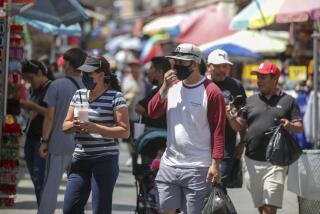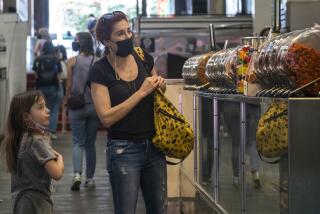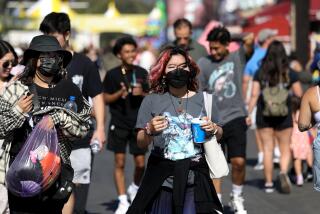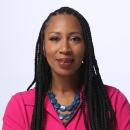L.A. releases first racial breakdown of coronavirus fatalities; blacks have higher death rate
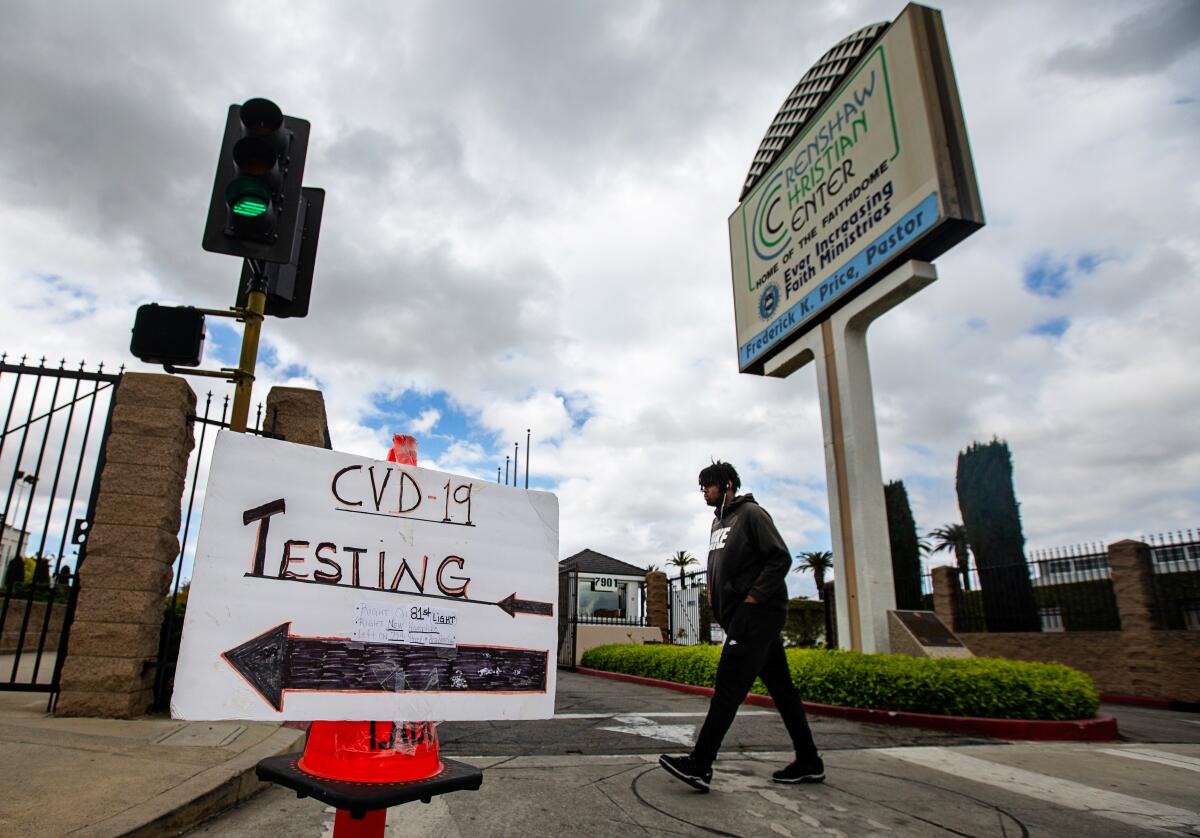
- Share via
As cities across the nation report that coronavirus is killing blacks in disproportionate numbers, Los Angeles County health officials released preliminary data Tuesday that showed black residents were dying at a slightly higher rate than other races.
The data, which LA County public health director Barbara Ferrer cautioned were based on just 57% of reported deaths so far, provide the first official snapshot of COVID-19’s impact on race in the state of California. The release follows recent findings that blacks are falling to the illness at higher rates than other races in cities like Chicago, Detroit, Milwaukee and Washington D.C.
“This data is preliminary because fully 43% of the people who passed we do not yet have information on their race and ethnicity and are working hard to be able to complete those records,” Ferrer said.
As of Tuesday, the county said that 169 people had died of COVID-19. Of those deaths, officials had racial information for 93 and released the following breakdown:
Latino 28%
White 27%
Asian 19%
Black 17%
Other 9%
“When we look at these numbers by the total population of each group, African Americans have a slightly higher rate of death than other races,” Ferrer said.
Black people make up 9% of the population of L.A. County.
Meanwhile, Latinos comprise nearly half the county population but 28% of deaths.
The coronavirus death percentages for white and Asian residents more closely matched their share of the county population.
Word of the finding prompted dismay among black community activists and officials, who say it speaks to enduring issues of trust between blacks and the healthcare system, as well as poor messaging and resources.
“I wasn’t surprised at all,” South Los Angeles activist Najee Ali said. “As the days go on, I believe the rates of African Americans will continue to rise disproportionately.”
Recently, a Los Angeles Times analysis found that many of L.A. County’s whitest and wealthiest enclaves were reporting far higher rates of infection than poorer neighborhoods of color. However, public health officials said those disparities did not necessarily mean the virus was spreading more widely through richer neighborhoods than in poorer ones. Instead, the reporting was likely skewed by uneven access to testing and, in some instances, by wealthy residents who traveled internationally and had some of the earliest confirmed infections.
The finding, some experts said, could be bad news for local efforts to control the spread of COVID-19, as it suggests a disparity of testing along the lines of race, income and immigration status that could be obscuring potential hot spots in disadvantaged communities and giving residents there the false impression that they have less to fear from the virus.
That is exactly what happened, Ali said.
“It’s clear that some of our young people didn’t take this seriously, which included passing on the myth initially that blacks couldn’t catch the coronavirus,” Ali said. “That myth spread like wildfire on social media, but there was never a concentrated effort from leaders to dispel that myth.”
California Surgeon General Dr. Nadine Burke Harris acknowledged Tuesday that this rumor had caused harm among blacks, and more needed to be done to dispel it.
“That rumor is completely false and its really important for all of us to get out there in debunking that rumor,” Harris said Tuesday. “One of the pieces that we also recognized is that because of the true and unfortunate history of medical maltreatment of different groups of people, but especially African Americans in the United States, there are real issues of trust between the African American community and the healthcare system.”
Blacks have been found to have higher rates of diabetes, high blood pressure, obesity and smoking-related deaths than whites, according to the Centers for Disease Control and Prevention. Also, they are more likely to not see a doctor because of the cost, CDC data shows.
These underlying health conditions coupled with a lack of access to affordable healthcare puts blacks at greater risk, said Chandra Ford, a professor at the UCLA Fielding School of Public Health.“There’s something about the context in which people live, the inequalities in our society, that render some groups more susceptible to the same exposure,” said Ford, founding director of the Center for the Study of Racism, Social Justice and Health at UCLA. “If they are exposed to the same thing another group is exposed to, they’ll fare worse.”
In addition to the racial composition of deaths, Los Angeles County also released the following breakdown of coronavirus cases where there is information:
White 870
Latino 735
Other 693
Asian 316
Blacks 283
Under Investigation 3,711
During his evening news conference Tuesday, Los Angeles Mayor Eric Garcetti said no group was immune to coronavirus. “But like many things in our society, this disease, especially the way it kills, is hitting folks with preexisting conditions … disproportionately found in poor communities and communities of color.”
“Long-term racial disparities still exist, he said.
Throughout much of the outbreak in the United States, Democratic lawmakers and local politicians have urged a closer accounting of race when it comes to reporting coronavirus testing, deaths and hospitalizations.
“It is indefensible not to be collecting complete demographic data — that means racial, ethnic, gender, age, national origin, all of that matters,” said County Sup. Mark Ridley-Thomas
He said he was stunned that the data weren’t already collected in the county.
“The largest county in the nation, the 17th largest economy in the world, and not being able to collect that data runs the risk of perpetuating disparities,” he said. “As a policymaker, decision maker, it gets pretty directly to the allocation of resources. If you don’t know where the problem is most pronounced, how do you know where to direct those resources? And we should know, we must know. There’s no excuse not to know.”
On Tuesday, Ferrer told reporters that COVID-19 testing “is happening much less” in poorer communities of L.A. County. “People who are living in wealthier communities have had, in fact, better access to testing and in fact have been tested more than people who are living in communities where income levels are much lower,” she said.
While more than 35,300 people have been tested as of April 6, with about 14% testing positive, Ferrer said, she believes there are more than 20,000 negative lab results that are not included in the county’s statistics. She hoped to have a more accurate count of the percent of people testing positive by the end of the week, and by early next week, produce a complete report on what they know about access to lab testing.
Ferrer has said that blacks and Native Americans are among the groups in L.A. County that share a disproportionate burden of illness going into a pandemic and are “much more likely to have higher rates of almost every illness that we collect information on.”
“Having serious underlying health conditions makes you at much higher risk for serious illness, and even death, from COVID-19,” she said. “
It remains unclear when the state will release overall data on race when it comes to the coronavirus. In Sacramento on Tuesday, Gov. Gavin Newsom said he had received preliminary data on race and hospitalizations, deaths and ICU patients, but that “we are still waiting for all of the data before I make it public and present it. I want it to be accurate, but that is being broken down in real time.”
Newsom said the same needed to be done with respect to testing.
“Disparities on testing are a point of obvious and real concern,” he said.
Times Staff Writers Soumya Karlamangla, Joseph Serna, Sarah Parvini and Colleen Shalby contributed to this report.
More to Read
Sign up for Essential California
The most important California stories and recommendations in your inbox every morning.
You may occasionally receive promotional content from the Los Angeles Times.
